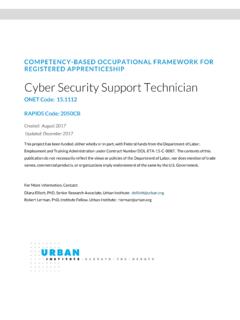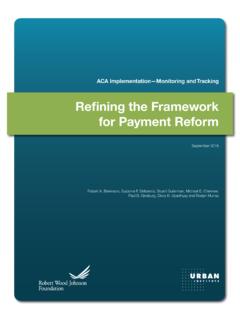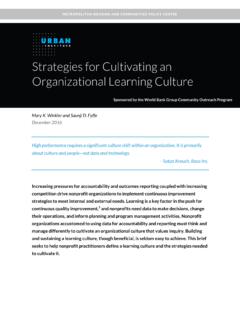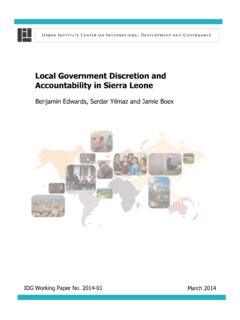Transcription of Strengths and Weaknesses of the Housing Voucher Program
1 Strengths and Weaknesses of the Housing Voucher ProgramMargery Austin TurnerThe views expressed in this testimony are those of theauthor and do not necessarily reflect the views of thetrustees and employees of the Urban Testimony of Margery Austin Turner, Director,Metropolitan Housing and Communities Policy Center, TheUrban Institute, prepared for the Committee on Financial Services, Subcommittee on Housing and CommunityOpportunity, United States House of Representatives, June 17, you for the opportunity to testify today on the Strengths and weakness of the federal Housing voucherprogram.
2 My testimony reviews the importance of the Housing choice Voucher Program and the benefits itprovides, and describes challenges facing the Program . I argue that the administration's proposal to convertthe Voucher Program into a state block grant does nothing to address these challenges and indeed couldmake them harder to overcome. Finally, I suggest three strategies that could strengthen the basic voucherprogram design, substantially improving outcomes for families. My remarks are based on research I and mycolleagues at the Urban Institute have conducted on federal Housing assistance programs and needs as wellas on the work of researchers at the Department of Housing and Urban Development and other public andprivate federal Housing choice Voucher Program plays a critical role in helping to address Housing needs forextremely low-income households.
3 Its most important advantage is that vouchers give recipients the freedomto choose the kinds of Housing and the locations that best meet their needs. As a consequence, many voucherrecipients live in healthy neighborhoods that offer social, educational, and economic opportunities forthemselves and their current Housing Voucher Program certainly does not work perfectly. Vouchers have not been as effectivein promoting residential mobility and choice among minority recipients as they have been for whites. Buteven for African Americans and Hispanics, vouchers perform better than public and assisted Housing projectsin giving families access to low-poverty and racially mixed all families who receive vouchers are able to find a house or apartment where they can use of moderately priced rental Housing , tight market conditions, racial and ethnic discrimination,landlords who are unwilling to accept Voucher payments, and ineffective local administration all contribute tothis problem.
4 And the Program 's "portability" feature, which allows recipients to use their vouchers to movefrom one jurisdiction to another, is a bureaucratic nightmare, not only for families but also for the sendingand receiving Housing single biggest problem with the current Housing Voucher Program is that federal spending for affordablehousing is woefully inadequate. Only about one in every three eligible families gets assistance. Thus, eventhough vouchers work quite well for those lucky enough to receive them, million low-income renters stillface severe Housing hardship paying more than half their monthly income for Housing , or living in seriouslyrun-down or overcrowded vouchers to a block grant does not address any of the Program 's current limitations and in fact,could well exacerbate existing problems.
5 Some states might use a block grant's flexibility to implementprogrammatic models that would potentially undermine the success of the Voucher approach, creating newproblems and worsening the Housing hardships that low-income families already face. Moreover, becausefunding for the Voucher Program would no longer be tied to a formula that reflects actual Program costs andrents, the gap between Housing needs and resources would almost certainly widen over time, underminingstates' ability to operate the Program promising strategies for making the basic Voucher design work better could be implemented within theexisting Program structure and could potentially improve outcomes for families substantially.
6 1) mobilitycounseling and assistance can help Voucher recipients understand the locational options available, identifyhousing opportunities, and negotiate effectively with landlords; 2) aggressive landlord outreach, service, andincentives can substantially expand the Housing options available to Voucher recipients; and 3) regionalcollaboration and/or regional administration of the Voucher Program can help address the administrativeDocument date: June 17, 2003 Released online: June 17, 2003collaboration and/or regional administration of the Voucher Program can help address the administrativebarriers to portability across jurisdictions, and make the Program more transparent to both landlords andparticipants.
7 Although it is possible that some states might choose to use a Voucher block grant to implementone or more of these promising strategies, this choice seems unlikely absent a programmatic mandate orincentive of the Housing choice Voucher ProgramThe federal Housing Voucher Program supplements rent payments for million low-income families andindividuals, making it the nation's largest Housing assistance Program . Recipients choose a house orapartment available in the private market and contribute about 30 percent of their incomes toward rent, whilethe federal government pays the difference up to a locally defined "payment standard.
8 " Compared tounassisted households at comparable income levels, Voucher recipients are far less likely to be payingunaffordable Housing cost burdens, and more likely to be living in decent quality Housing (HUD 2000). Andbecause the Voucher Program relies upon the existing Housing stock, it is less costly than programs that buildnew projects for occupancy by the poor (HUD 2000).The most important advantage of Housing vouchers is that they give recipients the freedom to choose thekinds of Housing and the locations that best meet their needs.
9 Federal Housing construction programs havehistorically clustered assisted families in low-income, central city neighborhoods, contributing to bothconcentrated poverty and racial segregation. For example, 37 percent of public Housing residents live inneighborhoods where the poverty rate exceeds 40 percent (Newman and Schnare 1997), and mostAfrican-American residents of public Housing live in neighborhoods that are majority black (Goering, Kamely,and Richardson 1994). Even more recent Housing production programs , such as the Low Income Housing TaxCredit and the HOME Program have placed a disproportionate share of assisted units in poor and minorityneighborhoods.
10 For example, almost half of LIHTC units are located in neighborhoods that are predominantlyblack (Buron et al. 2000).In contrast, vouchers have generally allowed assisted families to disperse more widely and to live inlower-poverty, less segregated neighborhoods. In fact, the latest research finds at least some voucherrecipients living in eight out of ten neighborhoods in large metropolitan areas. Specifically, Devine et al.(2003) analyze the spatial distribution of Voucher recipients in the nation's 50 largest metropolitan areas, andconclude that virtually every census tract in these areas contains some Housing at rent levels accessible tovoucher recipients; Voucher recipients are currently living in 83 percent of these census tracts.











